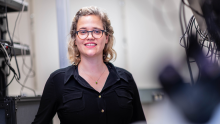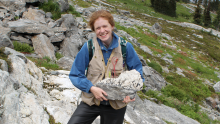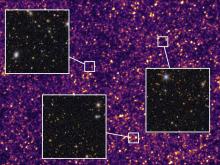NASA has approved funding for the Mars InSight lander, a mission that will enable scientists, including UBC geophysicist Catherine Johnson, to gather the first seismic information from any planet other than Earth.
"We’ve all been captivated by the Mars Rover's stunning images of the surface of Mars, and this is our chance to peer into the 'hidden' processes that shaped that landscape," says Johnson, the only Canadian on the mission's scientific team.
"This is a fantastic opportunity to determine whether the Red Planet is seismically active, how large its core is, and to determine why it doesn't have a magnetic field today."
The InSight lander is scheduled to launch in 2016 and land on Mars the same year. It would bore the deepest holes yet into Mars – to a depth of five meters – to install heat probe instrumentation below the surface, and place seismic instrumentation on the surface.
Part of Johnson's role in the mission will be to help analyze the more than 29 Gigabytes of seismic data sent back to Earth by the lander every year. She'll also work to locate where beneath Mars's surface quakes are happening, and to determine the size and state (liquid or solid) of Mars' core.
Johnson has previously worked on understanding Mars' ancient magnetic field and its relationship to the history of the planet's volcanic activity and the atmosphere. The InSight mission will help explain why Mars, unlike Earth, no longer has a magnetic field.
Johnson is currently a participating scientist on NASA's MESSENGER Discovery mission and an investigator on the OSIRIS REx New Frontiers Mission.
Led by Mars Exploration Rover project scientist Bruce Banerdt and other specialists from NASA's Jet Propulsion Lab, InSight's international science team includes co-investigators from the US, France, Germany, Austria, Belgium, Canada, Japan, Switzerland and the United Kingdom.
The lander is similar in design to the Mars lander that the Phoenix mission used successfully in 2007 to study ground ice near the north pole of Mars. The re-use of this technology will lower risks for the mission and keep costs down.
It will be equipped with two science instruments that will conduct the first check-up of Mars in more than 4.5 billion years, measuring its pulse, or internal activity, its temperature, and its gravitational field.
Scientists will be able to interpret this data to understand the planet's history, its interior structure and activity, and the forces that shaped rocky planet formation in the inner solar system.
InSight Mission Website
http://insight.jpl.nasa.gov
Catherine Johnson, Earth, Ocean and Atmospheric Sciences, UBC
E: cjohnson@eos.ubc.ca + cljcathy@gmail.com
C: 619-846-9566
Musqueam First Nation land acknowledegement
We honour xwməθkwəy̓ əm (Musqueam) on whose ancestral, unceded territory UBC Vancouver is situated. UBC Science is committed to building meaningful relationships with Indigenous peoples so we can advance Reconciliation and ensure traditional ways of knowing enrich our teaching and research.
Learn more: Musqueam First Nation
Faculty of Science
Office of the Dean, Earth Sciences Building2178–2207 Main Mall
Vancouver, BC Canada
V6T 1Z4


